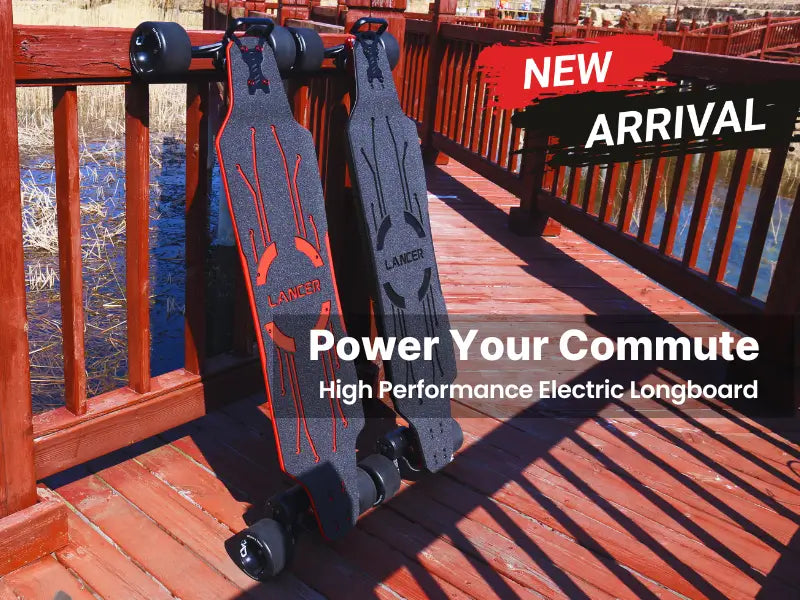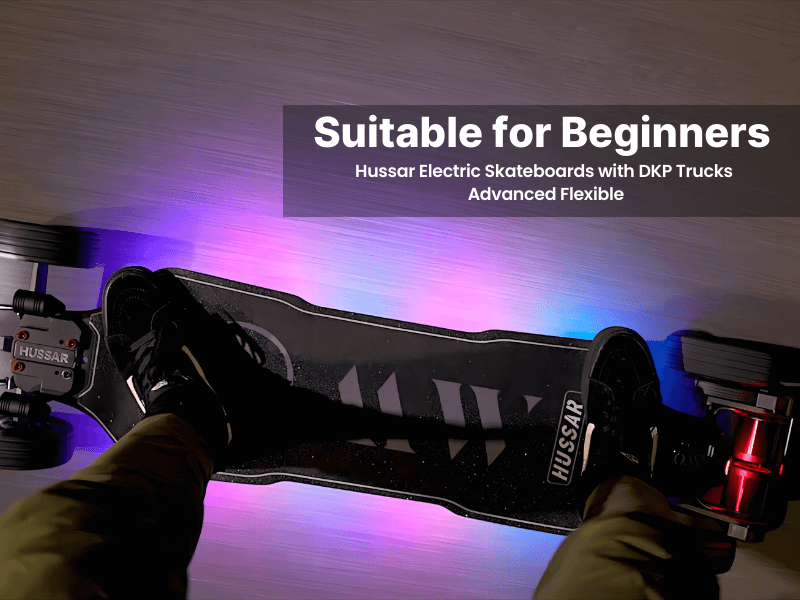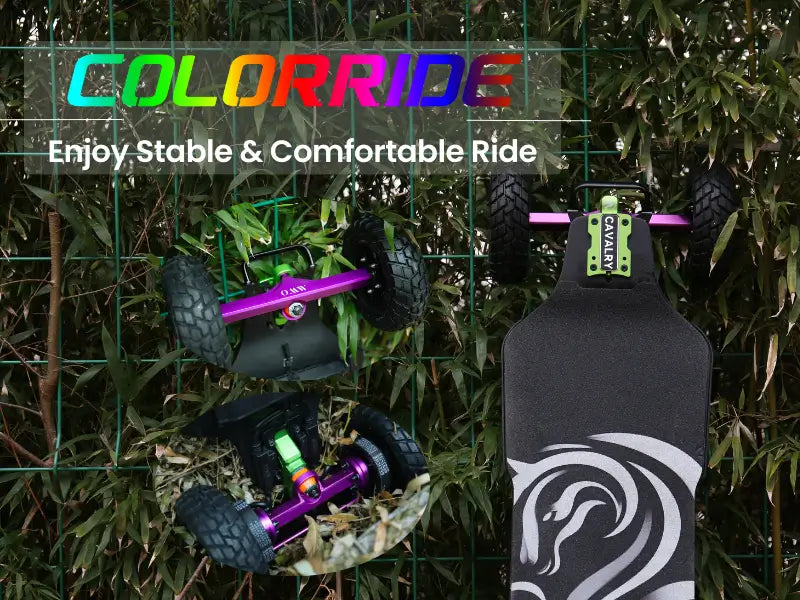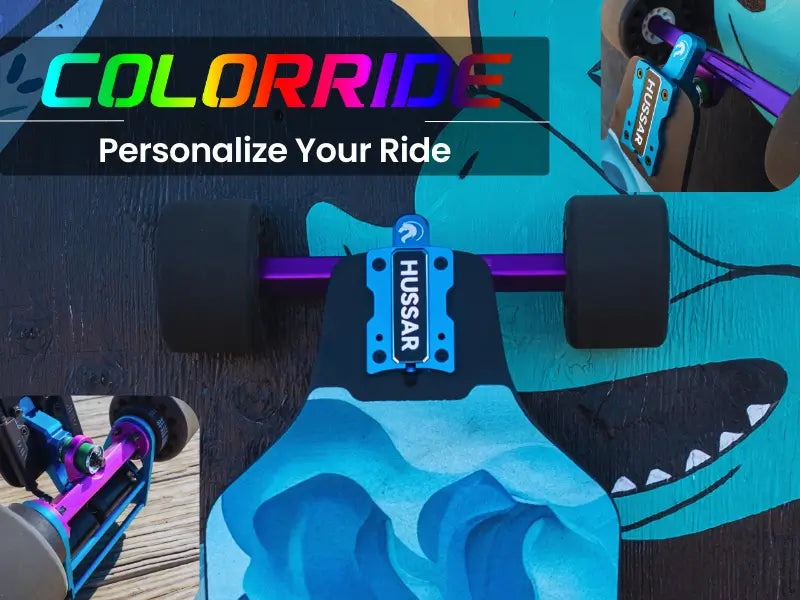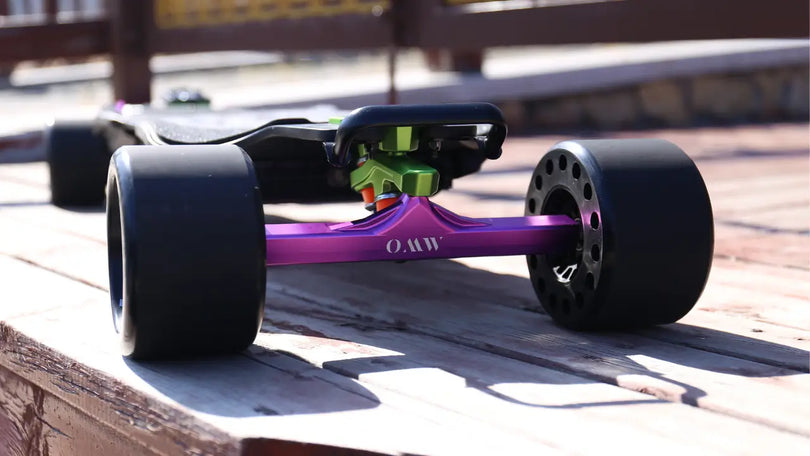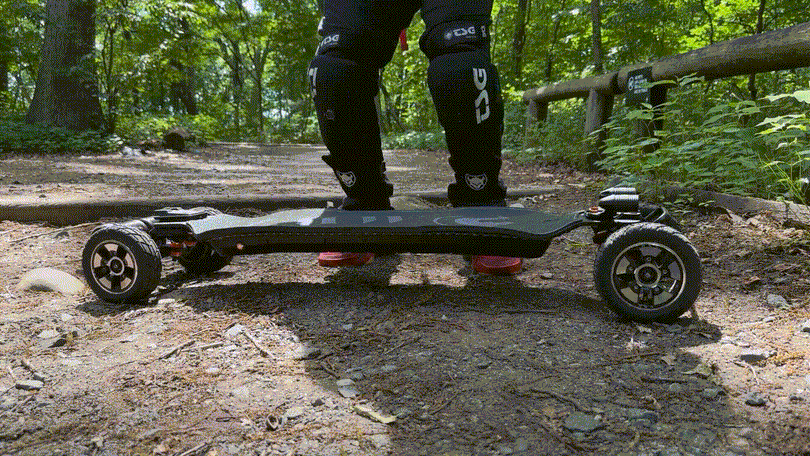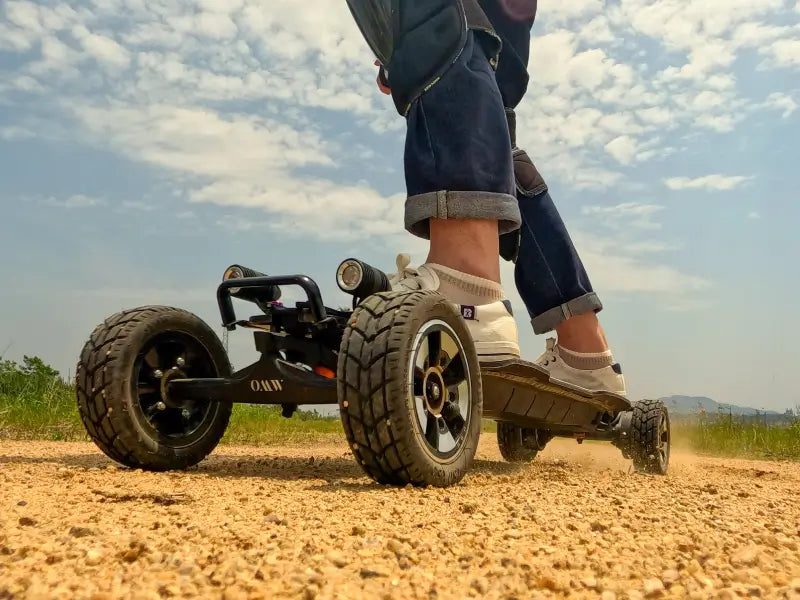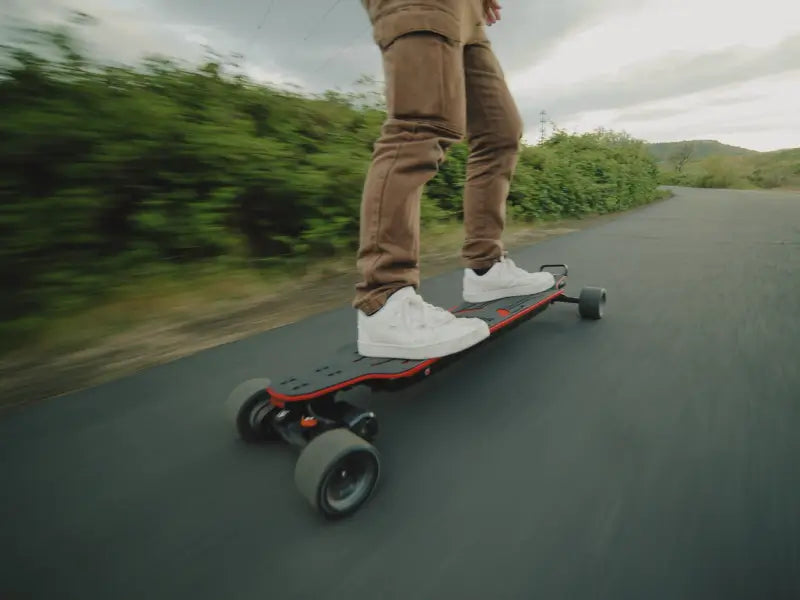The deck of an electric skateboard is more than just a platform; it's the core component dictating ride feel, stability, comfort, and overall performance. For DIY enthusiasts, selecting the right deck is crucial, as it lays the groundwork for the entire build, offering unparalleled customization options. In this article, let's talk about how to pick the perfect deck for your DIY electric skateboard.
I. Understanding Deck Construction: Shapes, Profiles, and Their Impact
The shape and profile of a deck are crucial to how a board rides. They directly influence foot placement, comfort, control, turning response, and high-speed stability.
A. Concave Designs: Grip and Foot Control
Concave refers to the curvature across the deck’s width, designed for better foot grip, enhanced control, and stable turning, especially during turns or high-speed riding.
Common Concave Types:
- Flat: No curvature; offers maximum foot space and flexibility, great for freestyle and tricks, but less grip.
- Radial Concave: A simple, smooth U-shape. Provides balanced grip without being too aggressive.
- Progressive Concave: A steeper version of radial concave with a stronger "locked-in" feel underfoot.
- Tub Concave: Flat in the middle with angled sidewalls; transfers energy efficiently from foot to deck.
- W-Concave: Two raised ridges create foot pockets, enhancing grip and board control—ideal for high-speed riding or downhill.
- Asymmetrical Concave: Varying sidewall angles for increased heel-side power, aiding dynamic carving and turning.
Many electric skateboards, such as OMW boards, feature subtle concaves or footwell shaping to provide natural foot locking, improving comfort and control during long-distance or high-speed riding. These designs help avoid wheel bite while enhancing rider safety and responsiveness.
 B. Longitudinal Profiles: Camber, Rocker, and Microdrop
B. Longitudinal Profiles: Camber, Rocker, and Microdrop
These profiles refer to the curve along the length of the deck, affecting how the board flexes and feels under your feet.
Types of Longitudinal Profiles:
- Camber: Deck arches upward in the center (convex). Offers a responsive, springy feel—perfect for carving and riders who enjoy a surf or snowboard-like experience.
- Rocker: Deck dips downward in the center (concave). Lowers the ride height, improving stability and control during slides and carving.
- 3D Rocker: An advanced variation that integrates wheel flares and foot pockets, preventing wheel bite while keeping the rider securely locked in.
- Micro-drop: A slight drop-down at the standing platform. Lowers the center of gravity and creates natural “gas pedals” for heel/toe leverage—ideal for heelside turns and high-speed tucking.
OMW Lancer features a subtle Microdrop profile, providing both ride comfort and enhanced board control without compromising the performance of a top-mount deck.
 C. Kicktails & Wheel Wells
C. Kicktails & Wheel Wells
- Kicktails: Raised sections at the ends of the deck. Useful for technical tricks, curb hopping, or quick pivot turns—especially in urban settings.
- Wheel Wells / Cutouts: Molded or cut-in clearances around the wheels. They prevent wheel bite—when the wheels touch the deck during deep turns, risking sudden stops or accidents.
Models like the Linnpower Viper and Exway Flex use flared wheel wells, allowing the use of larger wheels while enabling deeper carves without interference.
Ⅱ. Deck Materials: Balancing Durability, Flex, and Weight
The materials used in an Eskate deck significantly affect its durability, flexibility, weight, and overall ride characteristics. Choosing the right material depends on the rider’s style, weight, terrain, and performance expectations.
 A. Traditional Materials
A. Traditional Materials
Maple Wood
A time-tested favorite, maple is known for its strength, durability, and excellent shock absorption.
- Pros: High load capacity, stiff and responsive underfoot
- Cons: Heavier and less flexible than alternatives
- Best for: Trick riding, aggressive use, and heavier riders
Bamboo
Lightweight and naturally flexible, bamboo offers a smoother and more forgiving ride. Often paired with fiberglass or maple for added durability.
- Pros: Light, eco-friendly, comfortable flex
- Cons: Lower structural strength and load capacity
- Best for: Commuting, cruising, and carving
B. Advanced Composites
Fiberglass
Used mainly as a reinforcement layer to boost stiffness and strength without a large weight penalty. Typically combined with wood cores.
- Pros: Strong and lightweight, adds durability
- Cons: More expensive than traditional materials
- Best for: Speed-focused builds and intermediate riders wanting better control
Carbon Fiber
The gold standard for high-performance builds. It offers unmatched strength-to-weight ratio and extreme stiffness. Can be used with a foam core to minimize weight.
- Pros: Ultra-light, ultra-rigid, highly durable
- Cons: Expensive, can feel overly stiff
- Best for: Racing, high-speed riding, and performance-oriented setups
C. Hybrid & Custom Composites
Modern decks often blend materials to optimize performance. Multi-layer constructions—such as bamboo or carbon fiber combined with fiberglass—offer customized levels of flex, strength, and shock absorption.
OMW electric skateboards feature a flexible carbon composite structure that balances comfort and responsiveness while supporting riders up to 330lbs. This hybrid design ensures long-term durability without sacrificing ride quality.
Tips for Choosing the Right Material
- Beginners: Maple or bamboo decks offer reliable performance at a good value.
- Intermediate Riders: Fiberglass-reinforced boards provide a balance of strength, control, and cost.
- Advanced/Performance Riders: Carbon fiber or custom composite builds deliver premium performance at a premium price.
Understanding the material-flex-cost triangle is key for DIY builders and buyers alike, helping match material choices with ride expectations, terrain, and budget.
III. The Science of Flex: Balancing Comfort and Stability
Deck flex plays a vital role in ride comfort, handling, and high-speed control. Understanding “how flex works” and ” how to manage it” is key to building or choosing a board that fits your needs.
A. What Is Deck Flex?
Deck flex is primarily determined by material choice and ply count. Here's how it affects the ride:
- Flexible decks absorb road vibrations, making them more comfortable, especially on rough surfaces. They’re ideal for cruising, carving, or long-distance commuting.
- Stiff decks resist bending and lateral torsion, offering increased stability and control, especially at higher speeds.
✔️OMW boards’ carbon composite deck is engineered to strike a perfect balance—flexible enough to dampen vibrations, yet rigid enough for high-speed stability. It supports riders up to 330 lbs.
 B. Progressive Flex Patterns
B. Progressive Flex Patterns
Advanced decks now feature progressive flex designs—strategically engineered to deliver both comfort and control:
- Wider sections (near the trucks) are stiffer for added stability.
- Narrower midsections offer controlled flex to improve shock absorption and foot comfort.
✔️Boards like the Exway Flex use this technique to offer smooth riding without sacrificing control or safety.
C. DIY Vibration Dampening Techniques
For electric skateboard builders and tuners, reducing vibration is essential—not just for comfort, but also to protect electronics from shock damage.
Effective Vibration Dampening Methods:
- Deck Materials: Bamboo and select composite decks naturally absorb road chatter.
- Grip Tape: Use foam-based grip tape to minimize vibration felt underfoot.
Component Isolation:
- EVA foam sheets (1–10 mm) to pad batteries or internals
- Rubber/neoprene pads between the enclosure and deck
- Anti-vibration grommets or silicone rubber mounts
- Plastidip or silicone sealant to cushion direct contact points
⚠️Tip: When insulating components, always consider heat dissipation—over-insulation may trap heat and affect battery or ESC performance.
IV. Mounting Styles: Optimizing Component Space and Ride Feel
The way trucks are mounted on a deck directly impacts ride characteristics such as height, handling, and stability, as well as available space for batteries, ESCs, and other electronics. Understanding mounting styles is essential, especially for electric skateboard builders.
 A. Top Mount
A. Top Mount
Description: Trucks are mounted directly underneath the deck without any drop or cutout.
Ride Feel: Provides maximum leverage over the trucks, resulting in responsive handling.
-
Pros:
- Most available space beneath the deck—ideal for large enclosures and motors
- Better control and carving responsiveness
-
Cons:
- Higher ride height, which can reduce stability at high speeds
DIY Suitability: ★★★★☆
Highly recommended for DIY builds due to its generous component space.
B. Drop-Through
Description: Trucks pass through cutouts in the deck, allowing the baseplate to sit above it and lowering the deck closer to the ground.
Ride Feel: Offers a lower center of gravity, increasing stability and ease of pushing.
-
Pros:
- Lower ride height enhances stability and comfort
- Reduces risk of wheel bite
-
Cons:
- Less truck leverage = less responsive turning
- May cause "shoe bite" (deck edge hitting shoes during turns)
- Not ideal for very high-speed setups due to screw stress points
DIY Suitability: ★★★☆☆
More limited enclosure space; use cautiously with high-power components.
C. Drop-Down (or "Drop")
Description: The deck platform is molded to sit lower than the truck mounts, creating a dropped stance without cutouts.
Ride Feel: Offers the lowest center of gravity without compromising truck mounting strength.
-
Pros:
- Maximum stability at speed
- Natural foot pockets for a locked-in stance
- Great for slides and downhill control
-
Cons:
- Less leverage over trucks
- Can be too low for general urban or mixed riding
Example: OMW boards use a subtle drop-down profile to balance comfort with high-speed control.
DIY Suitability: ★★★★☆
Offers decent space with great ride feel for performance builds.
D. Double Drop
Description: Combines drop-through and drop-down styles, both lowered truck mounting and dropped deck profile.
Ride Feel: Ultra-low platform for unmatched stability.
-
Pros:
- Lowest possible center of gravity
- Ideal for downhill or highly controlled speed runs
-
Cons:
- Extremely difficult to manufacture and reinforce
- Minimal ground clearance—not ideal for general riding or electronics mounting
DIY Suitability: ★★☆☆☆
Rarely used in e-skate due to complexity and space limitations.
Final Notes for DIY Builders
When choosing a mounting style, consider your riding goals, terrain, and component size. Matching the right deck structure with your setup ensures better performance, safety, and reliability.
V. Common DIY Deck Challenges & Solutions
Building a DIY electric skateboard is a rewarding project, but it comes with specific challenges, especially when working with or modifying the deck. Addressing these issues early ensures safety, reliability, and long-term performance.
A. Preventing Wheel Bite
Issue:
Wheel bite occurs when the deck makes contact with the wheels during sharp turns, often causing dangerous, sudden stops.
Solutions:
- Install harder bushings (91A–94A) to reduce turning range
- Add risers (e.g., 1/8" rubber pads) between the trucks and the deck
- Tighten trucks slightly to limit excessive lean (avoid overtightening)
- Choose decks with wheel wells or flares pre-molded for clearance
- Apply wax to bite areas as a temporary friction-reducing measure
- Most importantly, develop good board control and lean management
B. Drilling & Cutting Techniques
Issue:
Drilling or routing can cause splintering, particularly on the exit side of wood or composite decks.
Best Practices:
- Use sharp or new drill bits suitable for wood or carbon
- Clamp a scrap wood backing to the exit side to prevent tear-out
- Apply masking tape on both entry and exit points for cleaner cuts
- Use a countersink bit to allow flush mounting and prevent deck cracking
C. Maintaining Structural Integrity
Proper mounting and protection of components is key to a safe, long-lasting build.
-
Component Mounting:
- Use skateboard-specific bolts and nylon lock nuts to securely attach trucks, ESCs, motors, and enclosures.
-
Battery Enclosure:
- Choose a durable enclosure that protects against impacts and debris. Ensure ventilation to prevent heat buildup. For example, OMW Cavalry features a suspended, fully enclosed aluminum-alloy armored battery compartment with dual isolated chambers—engineered specifically for optimal performance and maximum protection.
-
Vibration Protection:
- Use foam padding, rubber gaskets, or isolation mounts between the deck and electronics to protect batteries and ESCs from road vibrations.
-
Deck Material:
- Use strong, impact-resistant materials like maple, bamboo composites, or carbon fiber for structural integrity.
-
Cable Protection:
- Heat-shrink tubing around all exposed wires
- Seal routing channels with silicone or epoxy to prevent movement, wear, or water ingress
✅ Final Tip: Build Smart, Build Safe
A successful DIY build isn't just about component compatibility—it's about anticipating mechanical stress, ride dynamics, and long-term durability.
By mastering core techniques like wheel bite prevention, clean drilling, and structural reinforcement, you'll create a board that performs smoothly and holds up over time.
 Conclusion: Your Path to the Perfect DIY Electric Skateboard Deck
Conclusion: Your Path to the Perfect DIY Electric Skateboard Deck
The deck is the soul of a DIY electric skateboard—its shape, material, flex, and mounting style all profoundly influence comfort, control, and performance.
By understanding these details, you're empowered to make informed decisions and build a deck tailored to your unique style, terrain, and preferences. Remember: the perfect deck isn’t universal—it’s personal.

